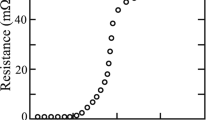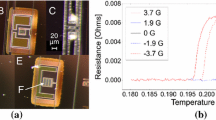Abstract
The Simons Observatory is building both large (6 m) and small (0.5 m) aperture telescopes in the Atacama Desert in Chile to observe the cosmic microwave background CMB radiation with unprecedented sensitivity. Simons Observatory telescopes in total will use over 60,000 transition edge sensor (TES) detectors spanning center frequencies between 27 and 285 GHz and operating near 100 mK. TES devices have been fabricated for the Simons Observatory by NIST, Berkeley, and HYPRES/SeeQC corporation. Iterations of these devices have been tested cryogenically in order to inform the fabrication of further devices, which will culminate in the final TES designs to be deployed in the field. The detailed design specifications have been independently iterated at each fabrication facility for particular detector frequencies. We present test results for prototype devices, with emphasis on NIST high frequency detectors. A dilution refrigerator was used to achieve the required temperatures. Measurements were taken both with 4-lead resistance measurements and with a time-domain Superconducting Quantum Interference Device (SQUID) multiplexer system. The SQUID readout measurements include analysis of current versus voltage (IV) curves at various temperatures, square wave bias step measurements, and detector noise measurements. Normal resistance, superconducting critical temperature, saturation power, thermal and natural time constants, and thermal properties of the devices are extracted from these measurements.





Similar content being viewed by others
References
N. Galitzki, et al., The simons observatory: instrument overview, in Proceedings of SPIE 10708, Millimeter, Submillimeter, and Far-Infrared Detectors and Instrumentation for Astronomy IX, 1070804, 31 July 2018. https://doi.org/10.1117/12.2312985
J.L. Orlowski-Scherer, N. Zhu, Z. Xu, et al., Simons Observatory large aperture receiver simulation overview, in Proceeding of SPIE 10708, Millimeter, Submillimeter, and Far-Infrared Detectors and Instrumentation for Astronomy IX, 107083X, 9 July 2018. https://doi.org/10.1117/12.2312868
K. Irwin, G. Hilton, Transition-edge sensors, in Cryogenic Particle Detection, Topics in Applied Physics, vol. 99, ed. by C. Enss (Springer, Berlin, 2005)
J.A.B. Mates, The Microwave SQUID Multiplexer. Physics Graduate Theses and Dissertations. vol. 9, (2011). https://scholar.colorado.edu/phys_gradetds/9
S.W. Henderson, et al., Highly-multiplexed microwave SQUID readout using the SLAC Microresonator Radio Frequency (SMuRF) electronics for future CMB and sub-millimeter surveys, in Proceedings of SPIE 10708, Millimeter, Submillimeter, and Far-Infrared Detectors and Instrumentation for Astronomy IX, 1070819, 18 July 2018. https://doi.org/10.1117/12.2314435
E.S. Battistelli, M. Amiri, B. Burger et al., Functional description of read-out electronics for time-domain multiplexed bolometers for millimeter and sub-millimeter astronomy. J. Low Temp. Phys. 151, 908 (2008). https://doi.org/10.1007/s10909-008-9772-z
A. Suzuki et al., Commercially fabricated antenna-coupled transition edge sensor bolometer detectors for next generation cosmic microwave background polarimetry experiment. J. Low Temp. Phys. (2020). https://doi.org/10.1007/s10909-019-02325-0
D. Li, J.E. Austermann, J.A. Beall et al., AlMn transition edge sensors for advanced ACTPol. J. Low Temp. Phys. 184, 66 (2016). https://doi.org/10.1007/s10909-016-1526-8
S.K. Choi, J. Austermann, J.A. Beall et al., Characterization of the mid-frequency arrays for advanced ACTPol. J. Low Temp. Phys. 193, 267 (2018). https://doi.org/10.1007/s10909-018-1982-4
B. Koopman, N.F. Cothard, S.K. Choi et al., Advanced ACTPol low frequency array: readout and characterization of prototype 27 and 39 GHz transition edge sensors. J. Low Temp. Phys. 193, 1103–1111 (2018). https://doi.org/10.1007/s10909-018-1957-5
K.D. Irwin, G.C. Hilton, D.A. Wollman, J.M. Martinis, Thermal-response time of superconducting transition-edge microcalorimeters. J. Appl. Phys. 83, 3978 (1998). https://doi.org/10.1063/1.367153
P.M. Laufer, D.A. Papaconstantopoulos, Tight-binding coherent-potential-approximation study of the electronic states of palladium—noble-metal alloys. Phys. Rev. B 35, 9019 (1987). https://doi.org/10.1103/PhysRevB.35.9019
P. Ade et al., The simons observatory: science goals and forecasts. J. Cosmol. Astropart. Phys. 2019, 56 (2019). https://doi.org/10.1088/1475-7516/2019/02/056
Acknowledgements
This work is supported by the Simons Foundation, Laboratory Directed Research and Development (LDRD) funding from Berkeley Lab, provided by the Director, Office of Science, of the US Department of Energy under Contract No. DE-AC02-05CH11231, Early Career Research Program (ECRP) program provided by the US Department of Energy, Office of Science, Office of High Energy Physics, under Contract No. DE-AC02-05CH11231, Small Business Innovative Research (SBIR) program provided by the US Department of Energy, Office of Science, Office of High Energy Physics, under award number DE-SC0018711 and award number HYP-DE-SC0017818. Work by NFC was supported by a NASA Space Technology Research Fellowship. MDN acknowledges support from NSF award AST-1454881.
Author information
Authors and Affiliations
Corresponding author
Additional information
Publisher's Note
Springer Nature remains neutral with regard to jurisdictional claims in published maps and institutional affiliations.
Rights and permissions
About this article
Cite this article
Stevens, J.R., Cothard, N.F., Vavagiakis, E.M. et al. Characterization of Transition Edge Sensors for the Simons Observatory. J Low Temp Phys 199, 672–680 (2020). https://doi.org/10.1007/s10909-020-02375-9
Received:
Accepted:
Published:
Issue Date:
DOI: https://doi.org/10.1007/s10909-020-02375-9




